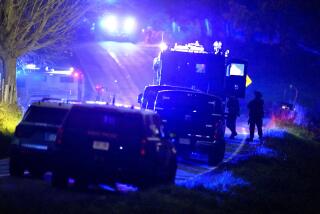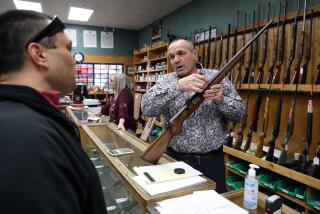Alaska Debates Arming Village Officers : Public safety: Rural law officers are closely watching whether the governor will sign a bill that would let residents carry concealed handguns. At present, people over 16 may carry weapons as long as they are visible.
- Share via
JUNEAU, Alaska — Angoon’s village public safety officer knows the troublemakers among the town’s 700 residents, and they know him.
They also know he’s not allowed to carry a gun.
“I’ve been to gunfights. I’ve had to wrestle with people who had loaded firearms,” said Mike Einfeldt, a village officer since 1988. “They might be much less apt to tangle with me if they thought I had a firearm.”
Alaska’s rural law officers, who are unarmed, are closely watching the fate of a bill approved by the Legislature to let Alaskans carry a concealed handguns. The measure is on Gov. Walter J. Hickel’s desk; he must decide by May 31 whether to sign it.
The legislation would allow residents over 21 to tuck a handgun into their purses or briefcases if they submit to fingerprinting and a background check, and pass a weapons-handling class.
Alaska currently allows people over 16 to carry weapons as long as they are visible--in a holster, for instance. Only police officers, or citizens who are hunting, hiking or in their own homes or businesses, may carry concealed weapons. No gun registration is required other than the federal Brady law requirements.
The bill has stirred debate over whether Alaska’s 99 village officers should carry weapons. The high cost of liability insurance has thus far precluded them from being armed.
Under the village-officer program, state money goes to regional agencies that hire and pay the officers and cover their insurance costs. If the agencies choose to send their officers to weapons-handling class and pay for the higher insurance premium, officers may be armed.
But arming the officers would add at least $600 to the $1,100 annual premium per officer, said David Taylor, the program’s insurance agent in Seattle.
Since the program began statewide 13 years ago, one village officer has been killed in the line of duty--ambushed by a man with a rifle.
The officers are always in a certain amount of danger, but the measure “potentially allows everyone a (village officer) comes in contact with to have a concealed weapon. We think it creates an unjustifiable risk that outweighs any potential benefit,” said George Cole, a retired state trooper who coordinates southeastern Alaska’s officers.
Supporters of the legislation say a concealed handgun could make people feel safer in cities like Fairbanks and Anchorage.
The bill’s sponsor, Jeannette Janes, said she knows village officers are worried. But she said a provision that allows towns to hold a referendum to ban concealed weapons should ease those fears.
In Angoon, an Admiralty Island village south of Juneau, village officers face many of the same risks that armed officers do, especially when they answer domestic violence complaints, Einfeldt said.
“We are told not to respond to calls where a weapon is involved. But we never know until we get there, and then we’re in a position of having to run and cover our backsides,” he said.
Sgt. Al Schadle, who helps oversee Alaska’s 99 village public safety officers for the state police, said unarmed officers may actually have an advantage.
“Once you arm a police officer, there’s the mind-set that goes, ‘Here comes a guy with a gun. I got to get a gun.’ With an unarmed officer,” he said, “you know up front he doesn’t pose a lethal threat.”
More to Read
Sign up for Essential California
The most important California stories and recommendations in your inbox every morning.
You may occasionally receive promotional content from the Los Angeles Times.













